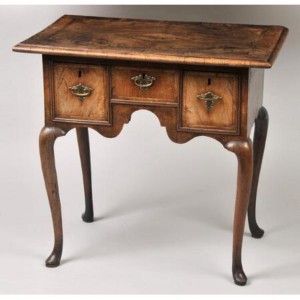If your eye is truly ” in ” then you will place the English ‘Queen Anne Walnut Period’ right at the top of your list of preferences. This short reign, 1702 – 1714 produced exquisite, quintessentially English, furniture. All the more remarkable because this elegant and highly disciplined period followed on from the reigns of William and Mary and the flamboyant Restoration of Charles 11 when emulating the extravagance of the applied arts at the Court of Louis X1V in France was all the rage.
This short period was renowned for its use of walnut and walnut veneers. If you take into account the fact that any furniture surviving for 300 years is something of a miracle, add the fact that walnut is highly susceptible to worm and damp and that in most cases walnut veneers were applied to inherently unstable pine carcasses, then not many items of genuine Queen Anne walnut furniture can possibly have survived. Those that have, command very high prices and are much in demand.
In particular during this period the ‘cabriole leg’ was refined to an ultimate perfection of simplicity unmatched by later craftsmen.
Naturally because of high demand and rarity, there are many fakes, reproductions and ‘alterations’. Where most reproductions and fakes have slipped up is in the use of machine cut veneers, early walnut veneer was hand sawn, later, machines produced wafer thin veneers in large quantities, relatively easy to spot. Colour and patina ( near impossible to fake ) is often your best guide. Genuine Antique English walnut over many years should have acquired a unique and fascinating depth of colour and surface.
The lovely Queen Anne walnut lowboy illustrated above is a great example of a rare survivor from the period and is in remarkably original state after some 300 years, even down to the brass mounts, it is raised on four exquisitely drawn cabriole legs. View here.
For further illustrations consult Percy Macquoid’s ” Age of Walnut “. An eminent collector and connoisseur of English Antique Furniture. 1852-1925.




